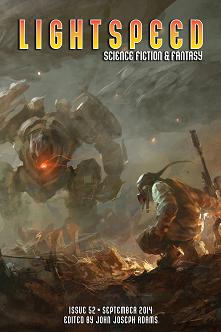 Lightspeed #52, September 2014
Lightspeed #52, September 2014
“Under the Scab” by Mathew Hughes
Reviewed by Ryan Holmes
“Under the Scab” by Mathew Hughes is the latest adventure in the Kaslo Chronicles. The story follows Erm Kaslo, henchman to the wizard Diomedo Obron, through the ruins of Novo Bantry, a technological world flung into an age of magic. Kaslo searches for refugees abducted by multi-legged creatures from another plane and enters that plane through a portal of whimsy. There he must adapt his senses to alien laws of physics, locate and rescue the refugees, and get out alive. What he discovers on the quest changes everything but may hold a glimmer of hope. Hughes uses the story to explore the psychological aspects of an environment devoid of sensory input. Kaslo must adapt to an existence where light, sound, and space have no meaning. The psychological theme is further explored when Kaslo’s consciousness encounters the entity behind the abduction with disastrous consequences. Neither science fiction nor fantasy, the story as a whole becomes a meld of both genres and makes for an entertaining adventure.
Sarah Pinsker’s “No Lonely Seafarer” is a well-crafted tale of Greek mythology. It centers on a child, Alex Turlington, who was sold into servitude to a caring inn keeper, and their fishing village, recently plagued by sirens. Captains, male and female, desperate to get home or to leave home for the open sea, contrive schemes to slip past the sirens and fail. One sailor, Captain Smythe, who sailed with Alex’s father, believes a child is the key and buys Alex’s bond from the inn keeper. Together they set out with Alex manning the sails while the captain is locked below. Pinsker’s story highlights the dangers of discontent. She uses the sailor’s homesickness when they are abroad and their sea lust when they are home to illustrate that we’ll never find happiness until we are at peace with ourselves.
“We Are the Cloud” by Sam J. Miller needs to come with a warning. The story is about a teenage boy in a boy’s home who has an obsession for other teen boys. Miller goes so far as to include a scene involving the boys in bed together and shooting a pornographic film. Science fiction elements are all but missing: people in Miller’s world sell a portion of their brains for implants linking them to the web at the cost of their intelligence. Miller’s underage, homosexual orphan suffers from this technology involuntarily at the hands of his addict mother, with whom he maintains a distanced relationship. Putting aside the offensive imagery of underage homosexuality in gratuitous proportions, we find a coming of age story that ends with a jaded protagonist betrayed by everyone he loves but finally of age and free to do whatever he wants and go wherever he wants, not that he wasn’t doing that already.
Saundra Mitchell’s “Starfall,” is about Amara, a woman with serious abandonment issues. The story pairs Amara’s life to that of KV-62, a star that went supernova four hundred twenty-two years ago on the same day as her birthday, or the day they found her in a trashcan. Amara’s abandonment issues lead to her working in a genealogy service where she converts hardcopies of records into an online database. She lives alone, has no friends, and believes no one is interested in her. The only science fiction elements to speak of are the supernova’s implied effects on the populace and a metaphorical reference to pi’s infinity. Mitchell’s story gushes with elements of literary fiction, but just in case the reader didn’t catch it, she explicitly spells it out in the denouement.
Ryan Holmes is a Marine Corps grunt turned aerospace engineer for NASA’s Kennedy Space Center and writes science fiction and fantasy in life’s scant margins. You can find his blog at: www.griffinsquill.blogspot.com